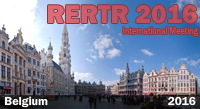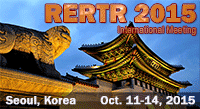Abstracts and Available Papers Presented at the
2004 International RERTR Meeting
INCREASING THE PERFORMANCE OF U-Mo FUELS
Enrique E. Pasqualini and Marisol López
Centro Atómico Constituyentes Av. Gral Paz 1499
(B1650KNA) San Martín Prov. Buenos Aires Argentina
ABSTRACT
Recent developments showed that uranium-molybdenum nuclear fuel particles dispersed in an aluminum matrix had misbehavior when irradiated at high neutron fluxes. The appearance of a third phase, with the presence of great porosity in the interaction zone of the Al/U-Mo interface, conditions severely the performance of this fuel. At the light of the resolution of this limitation, UMo monolithic fuel achieves a greater importance, since there is some expectation that in this bulk geometry the problem will not be present. From the simplest point of view, the addition of extra alloys to the aluminum matrix or to the nuclear fuel can be an alternative to reduce the interface growing kinetics and thereafter the appearance of the problematic third phase. The kinetics reduction would be a quantitative effect controlling chemical potentials (diffusion driving force) and barely will avoid the problem. Similar considerations can be attributed to the monolithic fuel if only quantitative solutions are proposed. In this paper are presented two drastical alternatives, from the point of view of qualitative metallurgy, for increasing the performance of U-Mo fuels. The first one is related with the coverage of the fuel particles with compound diffusion barriers to avoid the transportation of uranium and aluminum threw them. The second alternative is a monolithic fuel with zircaloy cladding where the interaction is much smaller than with aluminum. The basic assumptions in the particle coverage with diffusion barriers are that magnesium and uranium are immiscible and the high temperature coherent intermetalic Mg2Si is insoluble in a Mg and Si saturated (ppms) aluminum matrix. Magnesium, in contact with the nuclear material, will avoid uranium diffusion and Mg2Si, in between the previous barrier and the matrix, will avoid aluminum diffusion. Testing is being performed so as to develop coverage techniques by fused coating and chemical vapor deposition (CVD) that allow depositions of few microns thickness. Coverage results will be shown that involve magnesium, aluminum, silicon and some of their alloys. Feasibility of a U-Mo monolithic fuel with zircaloy cladding is being evaluated. Zircaloy has mechanical properties much similar to U-Mo alloy than aluminum and colamination tests are being set up. Other properties of both materials are considered such as thermal expansion, diffusion pairs, hot and cold rolling, corrosion resistance, hydriding techniques for recondition burned fuels, etc.
![]() PDF version available
PDF version available
DOWNLOAD full paper in PDF format.
Contact:
Dr. Jordi Roglans-Ribas
Technical Director, RERTR Department
Nuclear Engineering Division – 362
Argonne National Laboratory
9700 South Cass Avenue
Argonne, IL 60439
Fax: +1 630-252-5161
![]()




